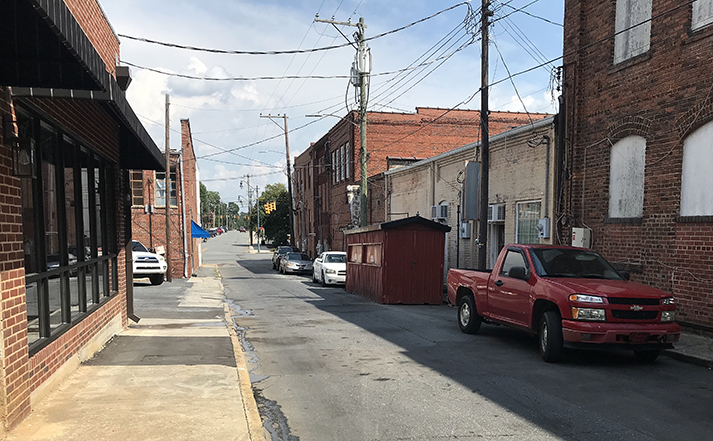Welcome!

The so-called ‘Red Barn’ dumpster should be one of the first things to go with the cleanup and modernizing of Trade Street in downtown Asheboro. Janet Imrick/Randolph Hub
First order of business in Trade Street Project: Dumping ‘the Red Barn’
Janet Imrick
Randolph Hub
ASHEBORO — Katherine Stroud, owner of Nannie Mae’s Cafe & Bakery, has been looking forward to getting rid of what Asheboro residents have named “the Red Barn” on Trade Street.
“Right now, it’s a hot mess,” she said. “It’s horrible to look at, and I hate for Full Moon to have those beautiful windows look out on that.”
Downtown Asheboro, Inc. (DAI) Executive Director Addie Corder shared Stroud’s sentiment. The removal of the long red dumpster near the Full Moon Oyster Bar will be the first phase in Trade Street streetscape project.
“Even just moving the trash and cleaning up that part of the street will be a positive impact,” Corder said.
New Restaurants Drive need
The project does not have a date, but Community Development Director Trevor Nuttall, recently promoted to assistant city manager, said it will not be until 2025. City staff paused the design process while they worked with Duke Energy Progress representatives on what to do with power lines.
It has been a long conversation about how to proceed with Trade Street. Corder said it’s one of the last downtown corridors needing to be addressed, particularly with the recent restaurant boom.
“Downtown has become more popular, more vibrant,” she said. “I see that trend post-COVID, where our economy is struggling on the retail side, but people still want to go out and eat.”
On Feb. 23, the city council discussed Trade Street during a special meeting facilitated by Piedmont Triad Regional Council Assistant Director Matt Reece. The city received $1.15 million from the state to renovate Trade Street, but council members learned it could cost an additional $650,000. The Wooten Company had design development plans roughly 65 percent complete before the city paused for discussions with Duke.
Corder said the project may take about eight months and be in two phases.
First, the Red Barn will be replaced with partially-buried dumpsters in the area of the grass lot and parking next to Walker Real Estate. At their July 11 meeting, the city council approved acquiring some of DAI’s property to install those.
Once the dumpster is out of the way, they can replace aged water and sewer lines on Trade Street. The city would like to bury power lines as they have done on Sunset Avenue, and Nuttall said their conversations with Duke have been encouraging.
“Duke has provided a cost estimate for its work that was below our initial estimate and is working collaboratively with us to execute the project,” he said.
Construction’s impact
When Stroud opened Nannie Mae’s, former DAI Director Rebekah McGee had just announced they were receiving the grant for Trade Street. Stroud and her husband have talked about how construction will affect day-to-day business, since they use the street for parking, loading and unloading.
Additionally, Stroud said there are safety concerns if their employees have to park further away and walk in the heat or in the dark. “I don’t want anything to ever happen to anybody, but let alone the girls we have here,” she said.
Corder said DAI and the city of Asheboro are working on communication plans for downtown establishments, alerting them when they might expect power or water to be shut off. She is looking at Walker Real Estate’s parking, the recreational center and Sunset Avenue for alternatives to employee parking and delivery unloading.
“I can’t make this process inherently seamless or easy,” Corder said. “But I can communicate and try to create alternative solutions during this less than convenient time while we get this project done. That’s where Downtown Asheboro is looking to help fill gaps.”
With all the new economic development opportunities for North, Sunset, Church, South Fayetteville and Worth Streets, the city feels that Trade Street’s turn has come.
“This is just an example of a space that was under-utilized from a pedestrian standpoint, that we’re seeing more traffic than ever,” Corder said.
Stroud is hopeful that the work on Trade Street will also provide opportunities to improve the customer experience at Nannie Mae’s. “I’m excited for the possibility,” she said. “Anything to beautify the town and to make it more friendly, walking friendly, is better for everybody.”
